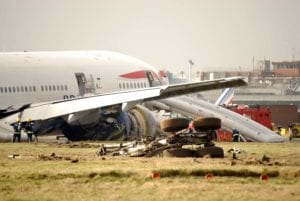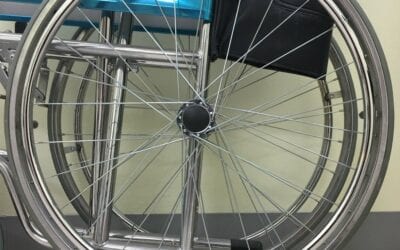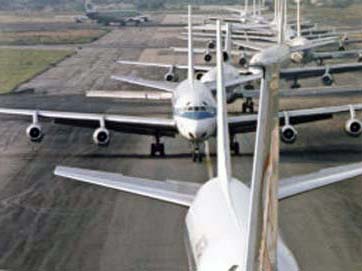Observers of FAA evacuation testing is a must
 In September, FAA Deputy Administrator Daniel Elwell announced that that the agency will conduct (secret) tests of airplane evacuations involving 720 “demographically representative” people over 12 days in November 2019 in Oklahoma City. These tests, the first conducted by the FAA in nearly two decades, come in response to a Congressional mandate that the agency set minimum seat size standards in order to increase passenger safety.
In September, FAA Deputy Administrator Daniel Elwell announced that that the agency will conduct (secret) tests of airplane evacuations involving 720 “demographically representative” people over 12 days in November 2019 in Oklahoma City. These tests, the first conducted by the FAA in nearly two decades, come in response to a Congressional mandate that the agency set minimum seat size standards in order to increase passenger safety.
What he didn’t say — in parenthesis above — is the important part of this FAA announcement. And there is more that is unsaid. For the FAA to continue down this secret road and make proprietary evacuation testing claims is exactly what got the Administration in trouble with the Boeing 737 debacle.
When it comes to airline safety testing, the US needs transparency and the unvarnished truth. The public deserves basic honesty from their civil servants, not carefully parsed phrases that can be interpreted several ways. Either a plane is safe and can be evacuated within 90 seconds. Or, it is not.
A consumer letter was sent requesting rules for testing
A letter from 10 consumer organizations was sent out to the Secretary of the Department of Transportation and to the Administrator of the Federal Aviation Administration. In the letter, consumers asked for the right to observe the testing and to have the results made public. Other issues were also raised in the letter and in discussions with the DOT Consumer Advocate, Blane Workie, and the Acting Deputy Secretary, Steven G. Bradbury. Both of these DOT executives promised to bring the consumer concerns to the Secretary and the Administrator prior to the November round of testing.
Though FAA spokespersons have been clarifying Deputy Administrator Elwell’s statement about the upcoming FAA testing at the hearing, consumer groups want some regulatory certainty added to his statement. The provisions of the FAA Reauthorization Bill are clear.
SEC. 337. AIRCRAFT CABIN EVACUATION PROCEDURES
CONSULTATION; REVIEW OF DATA.—In conducting the review under subsection (a), the Administrator shall—
(1) consult with the National Transportation Safety Board, transport-category aircraft manufacturers, air carriers, and other relevant experts and Federal agencies, including groups representing passengers, airline crew members, maintenance employees, and emergency responders; …
These instructions do not need to be interpreted. They need to be followed.
These FAA indications of testing rules are not following the law
So far, what consumers have learned through other FAA executives and through anecdotal comments is the following. These have been garnered from reported statements from Richard DeWeese, supervisor of the Aeromedical Engineering Sciences Section at the FAA Civil Aerospace Medical Institute and Stacey Zinke-McKee, branch manager of the Protection and Survival Research Lab at the FAA.
ALSO ON TRAVELERS UNITED: As airline seats get squeezed, safety suffers
- No outside observers will be permitted at the testing.
- Full plane evacuations are not planned.
- The FAA has never tested for seat size or legroom.
- The study will not look at children or disabled passengers.
- Is there a 90-second rule? It is being walked back, it seems.
- Seat-size specific data will be interpreted by experts but not tested against other parameters.
The FAA appears to be pressing forward with the testing without input from the DOT’s Office of Inspector General, which is currently conducting an audit of evacuation testing standards. The Administration has also bypassed the agency’s own emergency evacuation standards advisory committee.
Where are the group consultations required by the law?
There have been no consultations with groups representing passengers, airline crew members, maintenance employees, and emergency responders. These consultations are required by the bill language. In the consumer letter, several other testing requests of the DOT and FAA were made.
- Consumers asked that any testing of planes be done with a public that mirrors that of the US.
- Evacuations must reflect the increased passenger loads.
- The planes should take into account tighter seats and larger passengers.
- Increased carry-on luggage.
- Passengers will carry their luggage with them.
- Parents are now separated from their children.
- More electronics than ever are included onboard flights.
- Passengers with disabilities must be included.
Before any testing is done with real airplanes and real humans rather than only computer simulations, consumer groups urged the FAA to set some of these rules.
Previous testing was considered proprietary and not public — consumers need transparent and public evacuation testing of aircraft
In recent court cases brought by FlyersRights.org, a consumer group with a good legal team, the FAA was required to show that testing has been accomplished. Approaching the question of providing adequate personal space on planes was changed from one of customer service to one of safety by Travelers United when their President served on the Advisory Committee for Aviation Consumer Protection. And during the past half-a-decade, the remaining consumer groups have worked together to limit the scourge of reduced personal space on planes.
READ ALSO: How to evacuate a plane
Unfortunately, the FAA claims that rules and regulations are based on secret information. This makes it impossible for consumers to know how and why safety regulations are promulgated. As long as evacuation testing is considered secret and the airline industry is allowed to keep the results of testing proprietary the FAA cannot properly enforce rules and consumers cannot require airlines to live up to the rules.
All testing of regulations must be transparent
“There needs to be a fully transparent process with sufficiently representative stakeholder participation to ensure that the public can be confident that evacuation tests are realistic simulations of situations passengers would actually face in an emergency evacuation,” according to the consumer letter. “Absent such transparency, and stakeholder engagement, there is a danger that test results will simply be a ratification of seating configurations and evacuation procedures that would not pass muster under properly designed and acknowledged standards.”
It is essential that FAA evacuation testing does not simply rubber-stamp airlines’ current and future safety-questionable seating configurations for purposes of meeting the FAA’s 90-second evacuation threshold.

Charlie Leocha is the President of Travelers United. He has been working in Washington, DC, for the past 14 years with Congress, the Department of Transportation, and industry stakeholders on travel issues. He was the first consumer representative to the Advisory Committee for Aviation Consumer Protections appointed by the Secretary of Transportation from 2012 through 2018.



